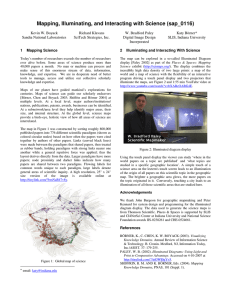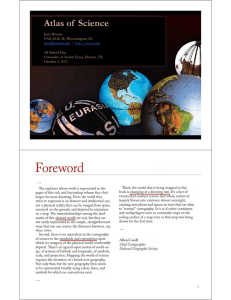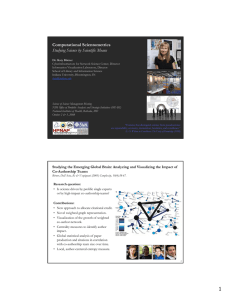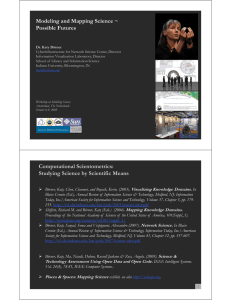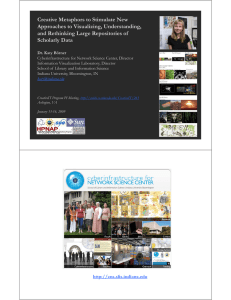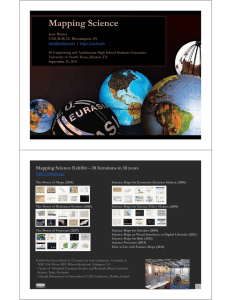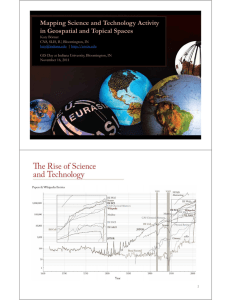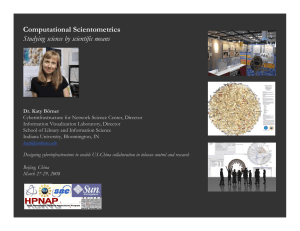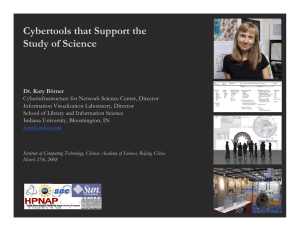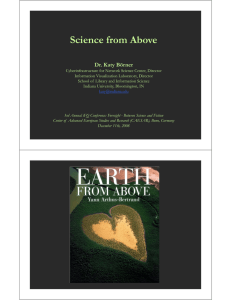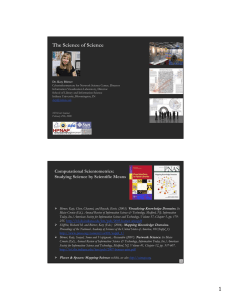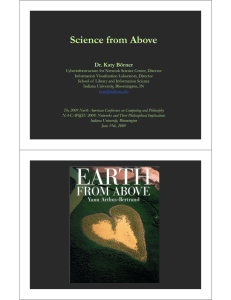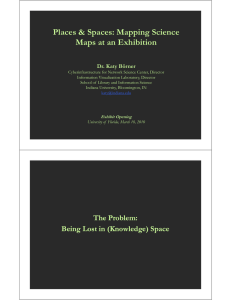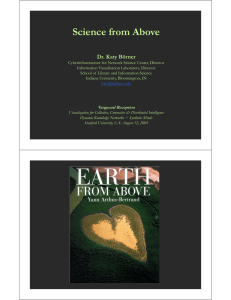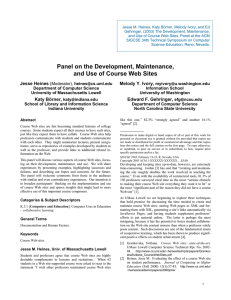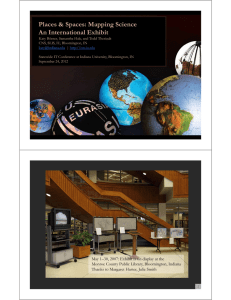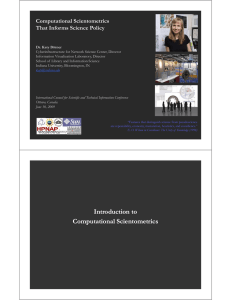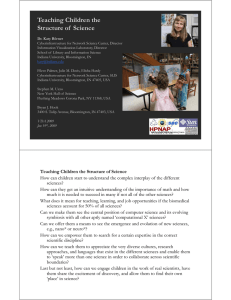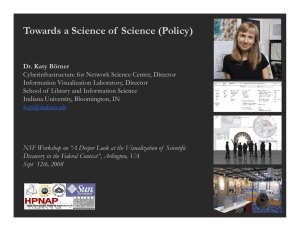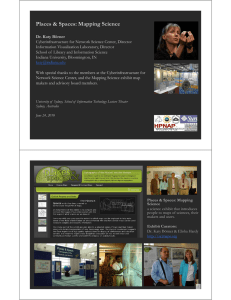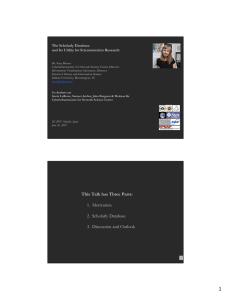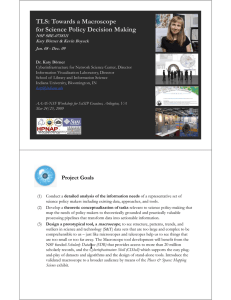2
advertisement
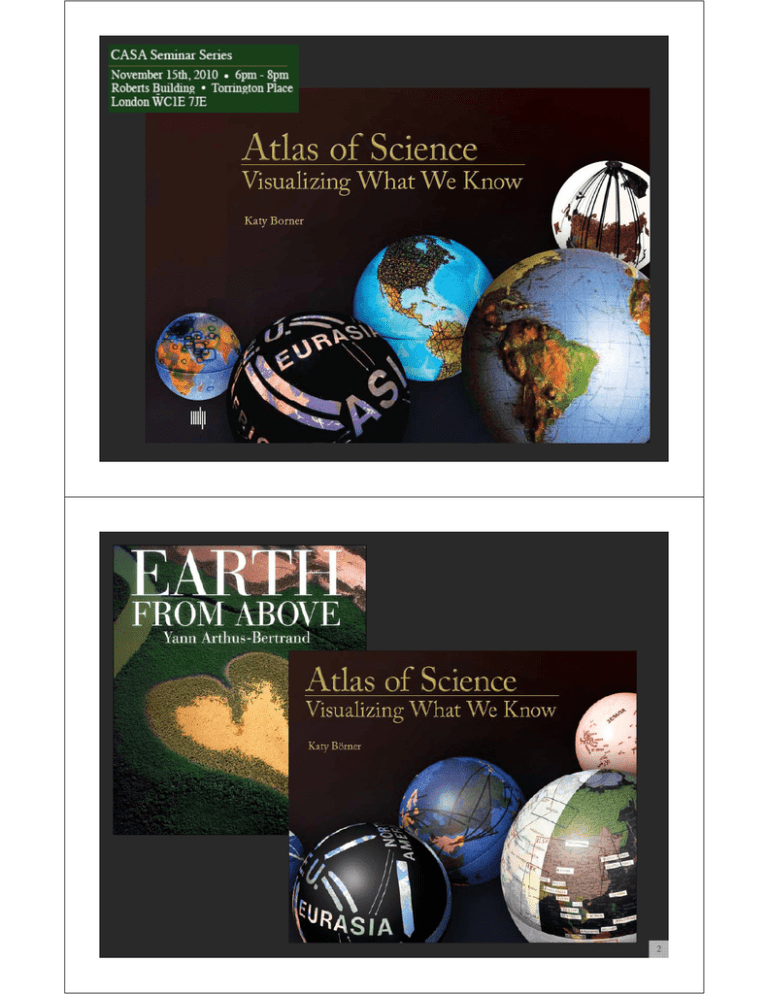
2 … … … 3 Early Maps of the World VERSUS 3D Physically-based Accuracy is measurable Trade-offs have more to do with granularity 2-D projections are very accurate at local levels Centuries of experience Geo-maps can be a template for other data Early Maps of Science n-D Abstract space Accuracy is difficult Trade-offs indirectly affect accuracy 2-D projections neglect a great deal of data Decades of experience Science maps can be a template for other data Kevin W. Boyack, UCGIS Summer Meeting, June, 2009 4 Find your way Black Box Find collaborators, friends Take terra bytes of data Identify trends 5 6 7 8 9 10 11 2005 World Population The population map uses a quarter degree box resolution. Boxes with zero people are given in white. Darker shades of red indicate higher population counts per box using a logarithmic interpolation. The highest density boxes appear in Mumbai, Mumbai with 11 11,687,850 687 850 people in the quarter degree block block, Calcutta (10 (10,816,010), 816 010) and Shanghai (8,628,088). 12 2007 IP Address Ownership This map shows IP address ownership by location. Each owner is represented by a circle and the area size of the circle corresponds to the number of IP addresses owned. The larges circle denotes MIT’s holdings of an entire class A subnet, subnet which equates to 16,581,375 16 581 375 IP addresses. addresses The countries that own the most IP addresses are US (560 million), Japan (130 million), Great Britain (47 million). 13 2003 Scientific Productivity Shown is where science is performed today. Each circle indicates a geographic location at which scholarly papers are published. The larger the circle the more papers are produced. Boston, MA, London, England, and New York NY are the top three paper production areas York, areas. Note the strong resemblance with the Night on Earth and the IP Ownership maps and the striking differences to the world population map. 14 2000 Night on Earth This image shows city lights at night. It was composed from hundreds of pictures made by orbiting satellites. The seaboards of Europe, the eastern United States, and Japan are particularly well lit. Many cities exist near rivers or oceans so that goods can be exchanged cheaply by boat. boat The central parts of South America, America Africa, Africa Asia, and Australia are rather dark despite their high population density, see map to the left. 15 In 1870, Captain George Everest embarked to map India by triangulation. triangulation For generations, generations a vast network of repeating sightline triangles was meticulously measured and recorded (see map below). What resembles a pattern of eyelashes on the northern border represents the sightlines to stations built above treetops. While analyzing the triangles in the calculating offices of Calcutta, the mapmakers discovered the highest peak in the world: Mount Everest 16 17 Legal Citation Index, 1873 Citation Indexes for Science, 1955 Google, 1998 18 1934 2007 19 20 21 22 23 24 25 31 35 36 37 38 40 41 42 Science as accumulation of knowledge. knowledge Areas of science are tube shaped. shaped Authors are mortal. Papers are immortal. “Scholarly brick laying”. Monsters = ‘the or of voids. onunknown’ the shoulders of giants. This drawing attempts toStanding shows the “structure” science. Crust of science “funding” or “usage”. Impactcan of represent funding on science (yellow). and badknit years. Densely communities Many are interestedGood to understand thecommunities. “dynamics” dynamics of science. science The importance of weak links. Hypothetical Model of the Evolution of Science - Daniel Zeller - 2007 48 49 50 Illuminated Diagram Display W. Bradford Paley, Kevin W. Boyack, Richard Kalvans, and Katy Börner (2007) Mapping, Illuminating, and Interacting with Science. SIGGRAPH 2007. Questions: p Who is doingg research on what topic and where? What is the ‘footprint’ of interdisciplinary research fields? p have scientists? What impact Large-scale, high resolution prints illuminated via projector or screen. Interactive touch panel. Contributions: Interactive, high resolution interface to access and make sense of data about scholarly activity. 51 52 53 Science Maps in “Expedition Expedition Zukunft” Zukunft science train visiting 62 cities in 7 months 12 coaches, 300 m long Opening was on April 23rd, 2009 by German Chancellor Merkel http://www.expedition-zukunft.de 54 55 56 57 58 Science Puzzle Map for Kids by Fileve Palmer, Julie Smith, Elisha Hardy and Katy Börner, Indiana University, 2006. (Base map taken from Illuminated Diagram display by Kevin Boyack, Richard Klavans, and W. Bradford Paley.) 59 60 61 Activities: Solve the puzzle. Navigate to ‘Earth Science’. Identify major inventions. Place major inventors. Find your dream job on the map. Why is mathematics important? 62 63 64 Mapping Science Exhibit – 10 Iterations in 10 years http://scimaps.org/ The Power of Maps (2005) Science Maps for Economic Decision Makers (2008) The Power of Reference Systems (2006) Science Maps for Science Policy Makers (2009) The Power of Forecasts (2007) Science Maps for Scholars (2010) Science S i M Maps as Vi Visuall IInterfaces t f to t Digital Di it l Libraries Lib i (2011) Science Maps for Kids (2012) Science Forecasts (2013) How to Lie with Science Maps (2014) Exhibit has been shown in 72 venues on four continents. Currently at - NSF, 10th Floor, 4201 Wilson Boulevard, Arlington, VA - Center of Advanced European Studies and Research, Bonn, Germany - Science Train, Germany - Cultural Dimensions of Innovation, UCD Conference, Dublin, Ireland 65 Debut D b off 5th Iteration I i off Mapping M i SScience i E Exhibit hibi at MEDIA X was on M May 18 18, 2009 at W Wallenberg ll b H Hall, ll Stanford University, http://mediax.stanford.edu, http://scaleindependentthought.typepad.com/photos/scimaps 66 67 Thi is This i the th only l mockup k in i this thi slide lid show. h E Everything hi else l iis available il bl today. d Bollen, Johan, Herbert Van de Sompel, Aric Hagberg, Luis M.A. Bettencourt, Ryan Chute, Marko A. Rodriquez, Lyudmila Balakireva. 2008. A Clickstream Map of Science. 69 Interactive Maps of Science – Philanthropy http://www.philanthropyinsight.org 70 http://www.livingscience.ethz.ch 71 Interactive World and Science Map of S&T Jobs Angela Zoss, Michael Connover, Katy Börner (2010) 72 Council for Chemical Research. 2009. Chemical R&D Powers the U.S. Innovation Engine. Washington, DC. Courtesy of the Council for Chemical Research. 73 74 http://scimaps.org We would ld lik like to thank h k the h map makers k 75 http://cns.slis.indiana.edu 77 Computational Scientometrics Cyberinfrastructures Scholarly Database: 25 million scholarly records http://sdb.slis.indiana.edu VIVO Research Networking h // i http://vivoweb.org b Information Visualization Cyberinfrastructure http://iv.slis.indiana.edu p Network Workbench Tool & Community Wiki http://nwb.slis.indiana.edu Science of Science (Sci2) Tool and CI Portal http://sci.slis.indiana.edu Epidemics Cyberinfrastructure http://epic.slis.indiana.edu/ 78 79
